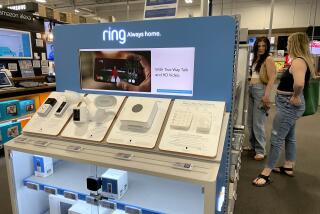Home, Tech Home : THE COMING BREAKTHROUGH IN ELECTRONICS COULD BE LOWER PRICES
- Share via
The 1980s witnessed a hailstorm of home-electronics hardware. The market was pelted by videocassette recorders, camcorders, big-screen TVs, compact disc players, laser disc players and home-theater systems.
But on the threshold of a new decade, the mighty development wells of the consumer electronics industry seem to have temporarily dried up.
“As far as ultra, ultra new products, there’s nothing new,” JVC senior vice president Harry Elias said.
With no breakthrough technology on the horizon, manufacturers are turning instead to current products, upgrading them and, most significantly, cutting their prices. It’s a buyer’s market right now for technology nuts.
“The biggest breakthroughs of the year are price breakthroughs,” said Michael Fidler, Pioneer’s senior marketing vice president.
At the June Consumer Electronics Show in Chicago, Pioneer turned some heads with its bargain-priced CLD-980. The combination laser disc and CD player retails for $500-about $400 discounted, which is a few hundred dollars less than most units.
“We’re enhancing and refining the technology that’s currently out there,” Fidler explained. “What we’re seeing is a higher level of activity in the true integration of audio and video technology.
As a result, the almost forgotten laser disc player is making a strong comeback. Living rooms are rapidly turning into home movie theaters with Dolby stereo, Surround Sound and Pro-Logic circuitry. And VCRs and camcorders are getting so sophisticated that users can practically shoot and edit a neighborhood newscast.
“We don’t see very many first-time VCR buyers anymore. They’re mostly second and third-time buyers willing to pay more money for higher-quality units,” Elias said.
VCRs have reached a near-saturation point. According to the Electronics Industry Assn, 64% of U.”. households have at least one.
To wring some extra profits from the VCR, manufacturers have developed TV/VCR combination units, with VCRs built right into the TV set. The no-hassle units are not high-tech, but they have no ugly wires or connections to contend with. The Goldstar KMV9012, Magnavox CRK120AT and Panasonic PVM2028 all list from $750 to $900.
The biggest changes in camcorders this year are their size, as each new wave of technology shrinks them. Sony’s 8mm CCD-TR4 model weighs in at 1 pound, 9 ounces. JVC has a VHS-C (the compact version of VHS) camcorder, the GR-AXU, that weighs an ounce more. And Panasonic has three new VHS-C Rpalmcorders.” The pint-sized camcorders from all three manufacturers range in price from $1,000 to $1,200.
Analysts predict that the next hot consumer product will be high definition television (HDTV), which provides a picture that rivals film. But the consumer introduction of HDTV isn’t likely until sometime in the mid-to-late 1990s. HDTV supporters say that when it hits, the product will cause a technological revolution. The American Electronics Assn. reports that HDTV could represent a $20 billion market in the United States by the year 2007.
In the meantime, TV sets just keep getting leaner-Sharp recently unveiled an inch-thin TV with a 14-inch screen-and meaner-Mitsubishi has a 120-inch projection-screen TV that goes for about $20,000. In lieu of HDTV, improved definition television (IDTV), a system that significantly enhances picture quality, is standard now on most higher-priced TV sets.
Of course, some pioneering companies are still searching for that elusive breakthrough.
Go-Video Inc. President R. Terren Dunlap has developed a double-deck VCR. The $995 VCR-2 can record two programs at once, record one program while the user is watching another video, or make high-quality duplications.
“A cartel of Japanese companies has been flooding the American consumer electronics market with VCRs and other products, and they have not introduced any innovative new products to meet needs and actually benefit consumers,” Dunlap said. “Instead, they make VCRs with clocks that flash 12 a.m. and nobody knows how to turn them off.”
A California-based company called 3-D TV Corp. is hyping its three-dimensional TV system. For about $200 you can buy a “Video Lunchbox,” which includes a small converter box, a set of special glasses and a three-dimensional videotape.
Metaview Corp. sells a $3,500 telecommunicating VCR that automatically records programs its owner is likely to watch. The TVCR makes a three-minute call once a week to Metaview’s central computer, which selects potential programs of interest based on a questionnaire filled out by the viewer. And for those who are really starving for new technology, Metaview offers a $10,000 TVCR model with a jukebox robot that can change 48 videocassettes and 432 compact discs.
More to Read
Inside the business of entertainment
The Wide Shot brings you news, analysis and insights on everything from streaming wars to production — and what it all means for the future.
You may occasionally receive promotional content from the Los Angeles Times.










